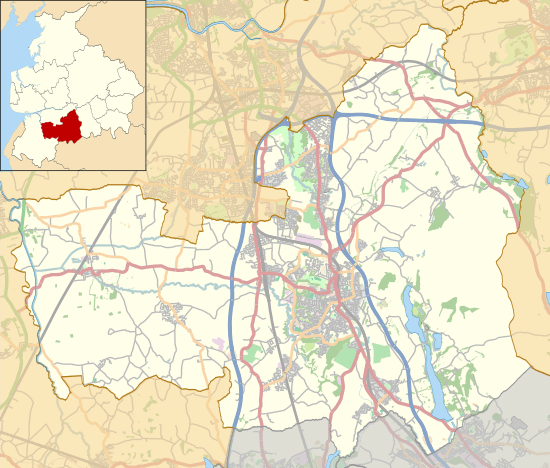Christ Church, Adlington
Christ Church is on Church Street, Adlington, Lancashire, England. It is a redundant Anglican church, and is recorded in the National Heritage List for England as a designated Grade II listed building.[1]
| Christ Church, Adlington | |
|---|---|
 Christ Church, Adlington Location in the Borough of Chorley | |
| OS grid reference | SD 601 132 |
| Location | Church Street, Adlington, Lancashire |
| Country | England |
| Denomination | Anglican |
| Architecture | |
| Functional status | Redundant |
| Heritage designation | Grade II |
| Designated | 21 February 1984 |
| Architect(s) | Edward Welch |
| Architectural type | Church |
| Style | Neo-Norman |
| Groundbreaking | 1838 |
| Completed | 1839 |
| Construction cost | £1,560 |
| Closed | 1 November 1980 |
| Specifications | |
| Materials | Ashlar, slate roof |
History
Christ Church was built in 1838–39, and designed by Edward Welch.[2] It was a Commissioners' Church, having received a grant towards its construction from the Church Building Commission.[3] The total cost of the church was £1,560 (equivalent to £140,000 in 2019)[4] towards which a grant of £400 was given.[3] When St Paul's Church was built on a different site in the town in 1884, Christ Church became its chapel of ease.[5] Christ Church was declared redundant on 1 November 1980, and on 7 April 1982 it was approved for use as an office or for shopping.[6] As of 2013, it is in use as a restaurant.[7]
Architecture
The church is in Neo-Norman style.[2] It is built in ashlar stone with a slate roof. The church consists of a six-bay nave and a short chancel under one roof. At the west end is a two-stage tower. In the bottom stage of the tower are angle pilaster buttresses and a round-headed west door. The second stage contains two lancet windows on three of its sides, and above this is an octagonal drum.[1] There was originally a spire, but this has been removed.[2] Along the sides of the nave are pilaster buttresses and round-headed lancet windows. The east window consists of five stepped lancets. On the south side of the chancel is a priest's door.[1] The interior has been altered, but three panelled galleries have been retained.[2]
See also
References
- Historic England, "Christ Church, Adlington (1362061)", National Heritage List for England, retrieved 29 October 2013
- Hartwell, Clare; Pevsner, Nikolaus (2009) [1969], Lancashire: North, The Buildings of England, New Haven and London: Yale University Press, p. 82, ISBN 978-0-300-12667-9
- Port, M. H. (2006), 600 New Churches: The Church Building Commission 1818–1856 (2nd ed.), Reading: Spire Books, p. 334, ISBN 978-1-904965-08-4
- UK Retail Price Index inflation figures are based on data from Clark, Gregory (2017). "The Annual RPI and Average Earnings for Britain, 1209 to Present (New Series)". MeasuringWorth. Retrieved 2 February 2020.
- Farrer, William; Brownbill, J., eds. (1911), "Townships: Adlington", A History of the County of Lancaster, Victoria County History, University of London & History of Parliament Trust, 6, pp. 217–220, retrieved 29 October 2013
- Diocese of Blackburn (PDF), Church of England, 1 October 2012, p. 1, retrieved 29 October 2013
- Sharju Indian Restaurant, Lancashire Curry Club, archived from the original on 26 June 2014, retrieved 29 October 2013
